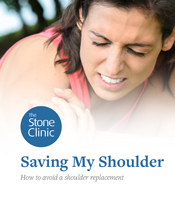Shoulder Pain Symptom Checker
If you’re not sure what might be wrong with your shoulder, our injury self-diagnosis tool is a good place to start.
It won’t replace a real doctor and cannot give a definitive diagnosis but it may help you better understand your symptoms.
1
Select your injury body area & symptom(s) below
2
Select from list of possible conditions
Disclaimer: This tool is for information purposes only and provides only an approximate guide as to what may be wrong with your joints. It should not be used instead of seeking professional medical advice or diagnosis.
Live in the San Francisco Bay Area?
Call for information or to book an appointment to see us in person
Outside of the Bay Area?
If, like many of our patients, you don't live in the Bay Area, we offer a complimentary phone consultation service.

Why Does My Shoulder Hurt?
If you are experiencing shoulder pain while sleeping, shoulder pain while exercising, sharp shoulder pain with overhead movement, or feeling instability, etc., it may be a minor concern or indicator of a serious issue.
Shoulder pain is usually caused by traumatic injuries, repetitive motion injuries, long-term wear & tear, or tissue disorders. Below are injuries that are common causes for shoulder pain, but it is best to gain a better understanding of your injury by entering your symptoms into our Shoulder Pain Diagnosis Symptom Checker and read Dr. Stone's blog article on shoulder pain and when you should consider surgery.
Common Shoulder Injuries
- Frozen Shoulder: or Adhesive Capsulitis is a general term denoting all causes of motion loss in the shoulder. Symptoms include trouble lifting your arm above your head, reaching across your body, or reaching behind your back. Can be associated with inflammatory arthritis, thyroid disease, or diabetes.
- Rotator Cuff Tear: a partial or complete tear of the rotator cuff, a system of four separate muscles that move and stabilize the humerus (arm bone) in the shoulder joint. The rotator cuff muscles and tendons may be injured by trauma, such as falling when skiing or biking, or from arthritic spurs that form within the shoulder and erode the cuff tissue over time.
- Clavicle Fracture: or a broken collarbone most often happens from falling and landing directly onto your shoulder, such as while bicycling, skiing, or snowboarding. The collarbone, or clavicle, is directly under the skin with very little overlying tissue, which makes fractures visible to the naked eye or even protrudes through the skin.
- Shoulder Arthritis: is the wear and tear of shoulder cartilage until bare bone is exposed. The shoulder joint can sometimes become narrowed and arthritic, and spurs can form on the undersurface.
- Shoulder Dislocation: A dislocated shoulder occurs when the humerus (upper arm bone) separates from the shoulder blade at the main shoulder joint. The shoulder is most often dislocated by a strong force or extreme rotation of the shoulder such as a hard hit during contact sports, a motor vehicle accident, or a fall. You may feel an inability to move your shoulder, intense pain, arm numbness, weakness, a visibly out of place shoulder, and/or swelling.
- Shoulder Separation: or an acromioclavicular (AC) joint separation occurs when the joint of the clavicle and the scapula are disrupted. This is often the result of direct trauma to the shoulder. AC joint separation symptoms may include shoulder instability and pain, especially when making overhead movements, crossbody movements, or during sleep. There may also be a pronounced bump or bulge at the joint line on the top of the shoulder.
Shoulder Pain Diagnosis Chart
Below is a chart that provides an approximate guide as to which part of the anatomy may be injured based on the location of your shoulder pain. It is for informational purposes only and should not be used instead of seeking professional medical advice or diagnosis.


